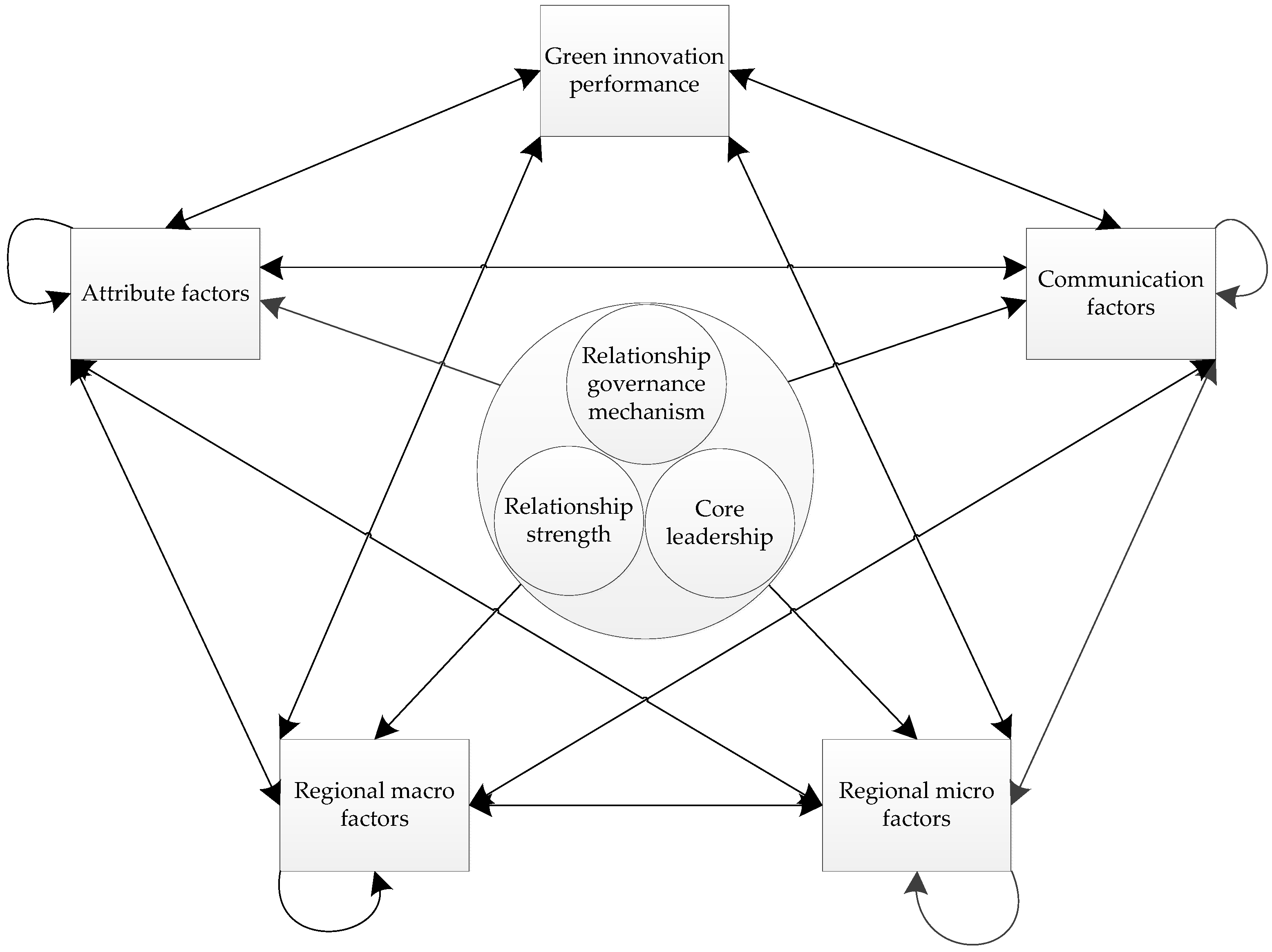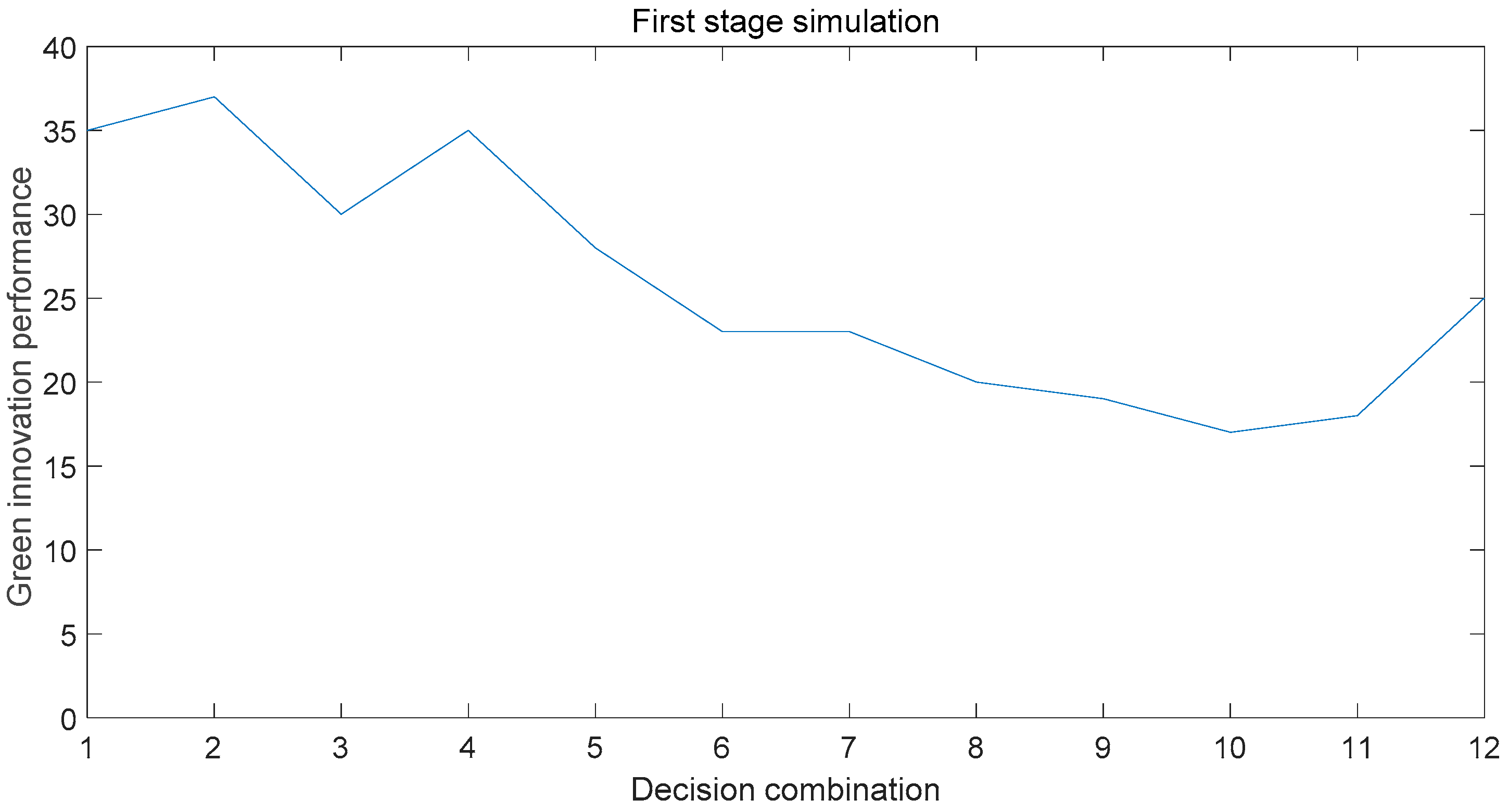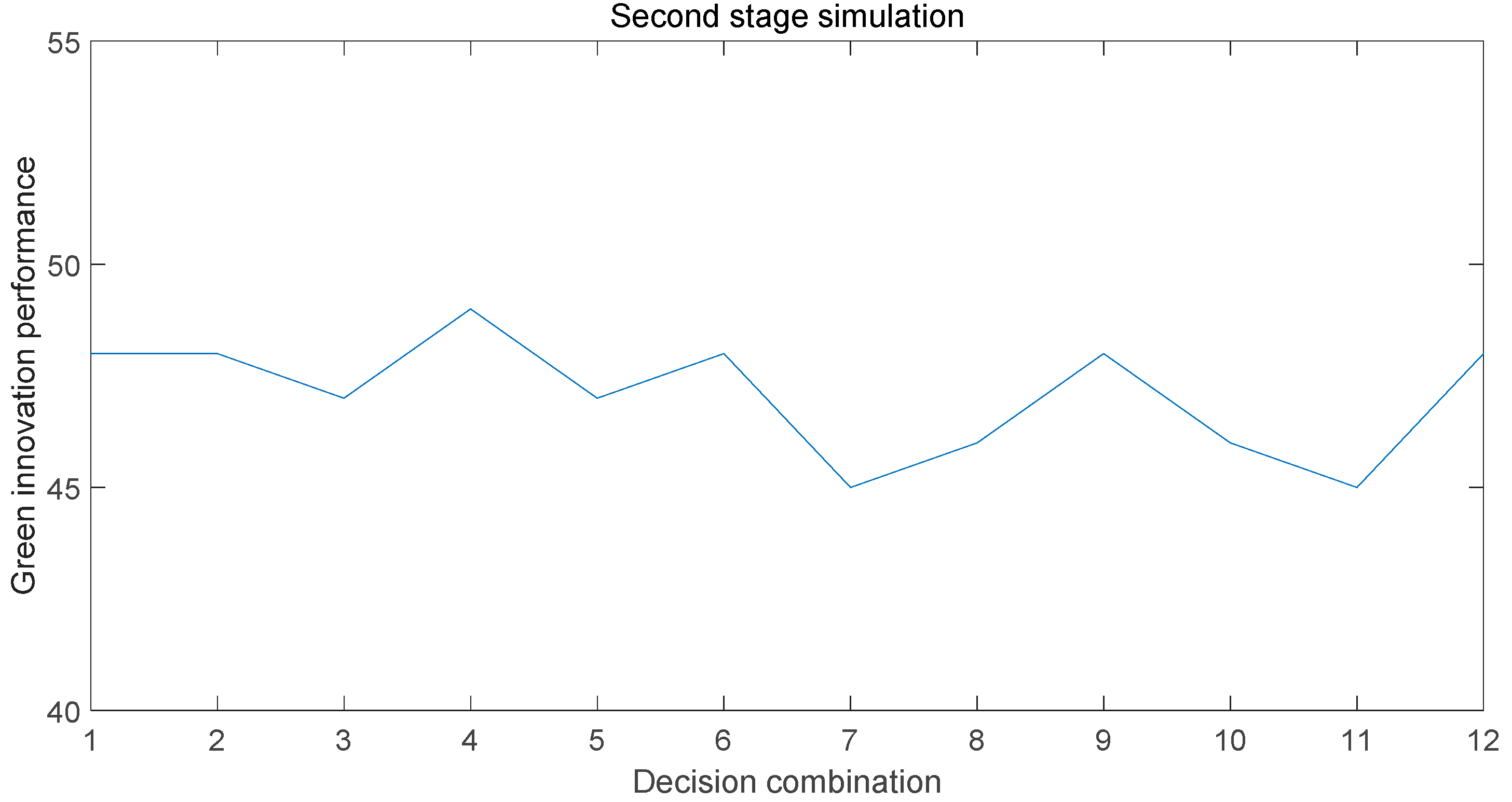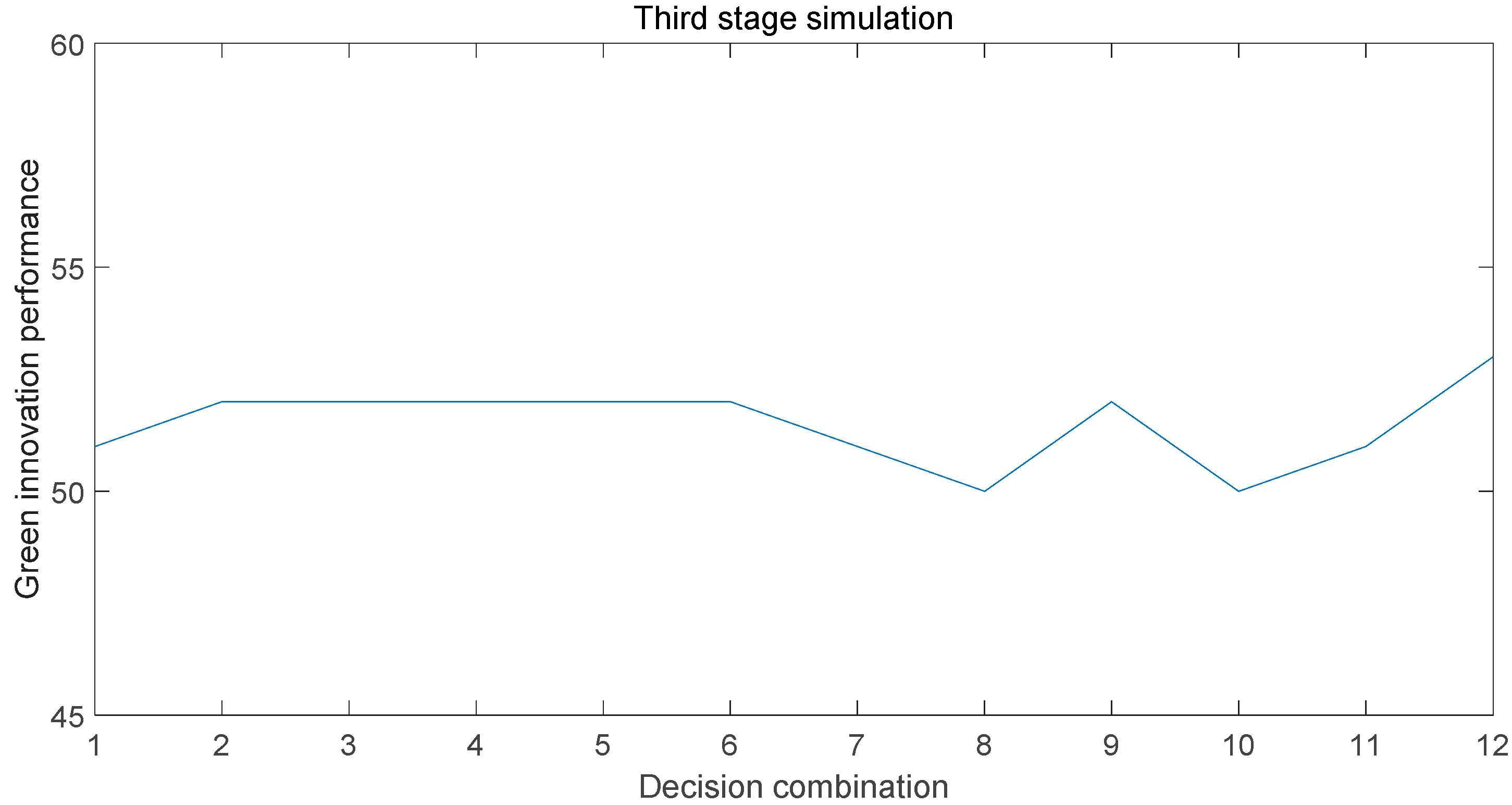Evolution Decision, Drivers and Green Innovation Performance for Collaborative Innovation Center of Ecological Building Materials and Environmental Protection Equipment in Jiangsu Province of China
Abstract
1. Introduction
2. Theoretical Background
3. Method
3.1. ANP and Impact Weight Analysis
3.2. Qualitative Simulation
3.2.1. Variable Description
3.2.2. Model Optimization
3.2.3. Simulation Algorithm
- At t0, the decision combination is formed by decision selection. Then, with the selected decision, the influence weight of the relevant network driver and the state value of the factor itself are calculated. The trend value qdiri1 of the network driving factor at the time t1 is obtained with the help of Equation (13):
- Through the conversion rule, the change value Ci1 of all of the state factors affected by the decision at step t1 is judged. The state value is increased or decreased. All of the network driver factor status values qvali1 at step t1 are obtained. According to the change value of all of the factors and the correlation value affecting the weight value, the trend of the network driver in step t2 is obtained through Equation (14):
- Through the conversion rule, the change value of all of the network driver factor state values with a mutual influence relationship at step t2 is judged. The state value is increased or decreased. All of the network driver factor state values at step t2 are obtained. As the step t progresses, the loop repeats steps c, d until all of the factor state values no longer change.
4. Case Analysis and Management Implication
5. Conclusions
Author Contributions
Funding
Acknowledgments
Conflicts of Interest
References
- Noni, I.D.; Orsi, L.; Belussi, F. The role of collaborative networks in supporting the innovation performances of lagging-behind European regions. Res. Policy 2018, 47, 1–13. [Google Scholar] [CrossRef]
- Ansoff, H. Corporate Strategy; McGraw-Hill Book Company: New York, NY, USA, 1987. [Google Scholar]
- Haken, H. The Science of Structure: Synergetics; Van Nostrand Reinhold: New York, NY, USA, 1984. [Google Scholar]
- Corning, P.A. The Synergism Hypothesis: A Theory of Progressive Evolution; McGraw-Hill Book Company: New York, NY, USA, 1983. [Google Scholar]
- Tidd, J.; Bessant, J. Managing Innovation: Integrating Technological, Market and Organizational Change; Wiley: Hoboken, NJ, USA, 2013. [Google Scholar]
- Baba, J.; Imai, K.I. Systemic Innovation and Cross-Border Networks: Transcending Markets and Hierarchies to Create a New Techno-Economic System; Institute of Business Research, Hitotsubashi University: Tokyo, Japan, 1989. [Google Scholar]
- Freeman, C. Network of Innovators: A Synthesis of Research Issues. Res. Policy 1991, 20, 499–514. [Google Scholar] [CrossRef]
- Xue, H.; Zhang, S.; Su, Y.; Wu, Z.; Yang, R.J. Effect of stakeholder collaborative management on off-site construction cost performance. J. Clean. Prod. 2018, 184, 490–502. [Google Scholar] [CrossRef]
- Rojas, M.G.A.; Solis, E.R.R.; Zhu, J.J. Innovation and network multiplexity: R&D and the concurrent effects of two collaboration networks in an emerging economy. Res. Policy 2018, 47, 1111–1124. [Google Scholar]
- Bigliardi, B.; Galati, F. Family firms and collaborative innovation: Present debates and future research. Eur. J. Innov. Manag. 2018, 21, 334–358. [Google Scholar] [CrossRef]
- Flores, M.; Boer, C.; Huber, C.; Pluss, A.; Schoch, R.; Pouly, M. Universities as key enablers to develop new collaborative environments for innovation: Successful experiences from Switerland and India. Int. J. Prod. Res. 2009, 47, 4935–4953. [Google Scholar] [CrossRef]
- Chang, R.D.; Soebarto, V.; Zhao, Z.Y.; Zillante, G. Facilitating the transition to sustainable construction: China’s policies. J. Clean. Prod. 2016, 131, 534–544. [Google Scholar] [CrossRef]
- Wu, W.; Liu, Y.; Chin, T.; Zhu, W. Will Green CSR Enhance Innovation? A Perspective of Public Visibility and Firm Transparency. Int. J. Environ. Res. Public Health 2018, 15, 268. [Google Scholar] [CrossRef] [PubMed]
- Ar, I.M. The Impact of Green Product Innovation on Firm Performance and Competitive Capability: The Moderating Role of Managerial Environmental Concern. Procedia Soc. Behav. Sci. 2012, 62, 854–864. [Google Scholar] [CrossRef]
- Chang, C.H. The Influence of Corporate Environmental Ethics on Competitive Advantage: The Mediation Role of Green Innovation. J. Bus. Ethics 2011, 104, 361–370. [Google Scholar] [CrossRef]
- Hadjimanolis, A. Barriers to innovation for SMEs in a small less developed country (Cyprus). Technovation 1999, 19, 561–570. [Google Scholar] [CrossRef]
- Maietta, O.W. Determinants of university—Firm R&D collaboration and its impact on innovation: A perspective from a low-tech industry. Res. Policy 2015, 44, 1341–1359. [Google Scholar]
- Hepburn, C.; Pless, J.; Popp, D. Policy Brief—Encouraging Innovation that Protects Environmental Systems: Five Policy Proposals. Rev. Env. Econ. Policy 2018, 12, 154–169. [Google Scholar] [CrossRef]
- Qi, G.Y.; Shen, L.Y.; Zeng, S.X.; Jorge, O.J. The drivers for contractors’ green innovation: An industry perspective. J. Clean. Prod. 2010, 18, 1358–1365. [Google Scholar] [CrossRef]
- Lee, J.; Mo, J. Analysis of Technological Innovation and Environmental Performance Improvement in Aviation Sector. Int. J. Environ. Res. Public Health 2011, 8, 3777–3795. [Google Scholar] [CrossRef] [PubMed]
- Albort-Morant, G.; Leal-Rodríguez, A.L.; Henseler, J.; Cepeda-Carrion, G. Potential and Realized Absorptive Capacity as Complementary Drivers of Green Product and Process Innovation Performance. Sustainability 2018, 10, 381. [Google Scholar] [CrossRef]
- Horowitz, C.R.; Shameer, K.; Gabrilove, J.; Atreja, A.; Shepard, P.; Goytia, C.N.; Smith, G.W.; Dudley, J.; Manning, R.; Bickell, N.A.; et al. Accelerators: Sparking Innovation and Transdisciplinary Team Science in Disparities Research. Int. J. Environ. Res. Public Health 2017, 14, 225. [Google Scholar] [CrossRef] [PubMed]
- Du, B.S.; Liu, Q.; Li, G.P. Coordinating Leader-Follower Supply Chain with Sustainable Green Technology Innovation on Their Fairness Concerns. Int. J. Environ. Res. Public Health 2017, 14, 1357. [Google Scholar] [CrossRef] [PubMed]
- Weng, H.-H.R.; Chen, J.-S.; Chen, P.-C. Effects of Green Innovation on Environmental and Corporate Performance: A Stakehoider Perspective. Sustainability 2015, 7, 4997–5026. [Google Scholar] [CrossRef]
- Triguero, A.; Moreno-Mondéjar, L.; Davia, M.A. Drivers of different types of eco-innovation in European SMEs. Ecol. Econ. 2013, 92, 25–33. [Google Scholar] [CrossRef]
- Robertson, J.L.; Carleton, E. Uncovering How and When Environmental Leadership Affects Employees’ Voluntary Pro-Environmental Behavior. J. Leadersh. Organ. Stud. 2018, 25, 197–210. [Google Scholar] [CrossRef]
- Liu, T.; Wan, Z. Relationship Input, Governance Mechanism, Equity and Knowledge Transfer: The Regulating Effect of Dependence. J. Manag. Sci. 2016, 29, 115–124. [Google Scholar]
- Kim, Y.; Choi, T.Y. Tie Strength and Value Creation in the Buyer-Supplier Context: A U-Shaped Relation Moderated by Dependence Asymmetry. J. Manag. 2015, 44, 1029–1064. [Google Scholar] [CrossRef]
- Melamed, D.; Simpson, B. Strong ties promote the evolution of cooperation in dynamic networks. Soc. Netw. 2016, 45, 32–44. [Google Scholar] [CrossRef]
- Ding, R.; Zhang, N.; Li, Y. Research on Double Center Social Network of Industry-University-Research Cooperation Project. Sci. Res. Manag. 2012, 33, 86–93. [Google Scholar]
- Țăpurică, O.C.; Ispășoiu, C.E. Analyzing the Influence of Environmental Leadership on Pollution Abatement Costs. Young Econ. J. Rev. Tinerilor Econ. 2013, 10, 117–126. [Google Scholar]
- Boiral, O.; Cayer, M.; Barbo, C.M. The Action logics of Environmental leadership: A Developmental Perspective. J. Bus. Ethics 2009, 85, 479–499. [Google Scholar] [CrossRef]
- Wehrmeyer, W.; Parker, K.T. Identification, Analysis and Relevance of Environmental Corporate Cultures. Bus. Strateg. Environ. 1995, 4, 145–153. [Google Scholar] [CrossRef]
- Sugita, M.; Takahashi, T. Influence of Corporate Culture on Environmental Management Performance: An Empirical Study of Japanese Firms. Corp. Soc. Responsib. Environ. Manag. 2015, 22, 182–192. [Google Scholar] [CrossRef]
- Kotter, J.P. How Leadership Differs from Management; Free Press: New York, NY, USA, 1990. [Google Scholar]
- Saunila, M.; Ukko, J.; Rantala, T. Sustainability as a driver of green innovation investment and exploitation. J. Clean. Prod. 2018, 179, 631–641. [Google Scholar] [CrossRef]
- Lin, H.; Zeng, S.X.; Ma, H.Y. Can Political Capital Drive Corporate green innovation? Lessons from China. J. Clean. Prod. 2014, 64, 63–72. [Google Scholar] [CrossRef]
- Ba, S.; Lisic, L.L.; Liu, Q.; Stallaert, J. Stock Market Reaction to Green Vehicle Innovation. Prod. Oper. Manag. 2013, 22, 976–990. [Google Scholar] [CrossRef]
- Lioutas, E.D.; Charatsari, C. Green innovativeness in Farm Enterprises: What Makes Farmers Think Green? Sustain. Dev. 2018, 26, 337–349. [Google Scholar] [CrossRef]
- Freire, P.A. Enhancing innovation through behavioral stimulation: The use of behavioral determinants of innovation in the implementation of eco-innovation processes in industrial sectors and companies. J. Clean. Prod. 2018, 170, 1677–1687. [Google Scholar] [CrossRef]
- Kessler, J.B.; Leider, S. Norms and Contracting. Manag. Sci. 2012, 58, 62–77. [Google Scholar] [CrossRef]
- Huo, B.; Fu, D.; Zhao, X. Curbing opportunism in logistics outsourcing relationships: The role of relational norms and contract. Int. J. Prod. Econ. 2016, 182, 293–303. [Google Scholar] [CrossRef]
- Yongman, K. The effect of company’s reputation, credibility, and familiarity of sports goods companies on company identification, attitude toward brand, and loyalty. Korean J. Phys. Educ. 2009, 48, 277–289. [Google Scholar]
- Guo, Y.; Xia, X.; Zhang, S. Environmental Regulation, Government R&D Funding and Green Technology Innovation: Evidence from China Provincial Data. Sustainability 2018, 10, 940. [Google Scholar]
- Carrion-Flores, C.E.; Innes, R. Environmental innovation and environmental performance. J. Environ. Econ. Manag. 2010, 59, 27–42. [Google Scholar] [CrossRef]
- Doran, J.; Ryan, G. The Importance of the Diverse Drivers and Types of Environmental Innovation for Firm Performance. Bus. Strateg. Environ. 2016, 25, 102–119. [Google Scholar] [CrossRef]
- Lee, B.-H. The Effects of The Utilization of External Resources on the Technological Innovation Performance along the Stages of Growth in Korean Ventures. Asia-Pac. J. Bus. Ventur. Entrep. 2012, 7, 35–45. [Google Scholar]
- Saaty, T.L. Theory and Applications of the Analytic Network Process: Decision Making with Benefits, Opportunities, Costs, and Risks; Beijing Institute of Technology Press: Beijing, China, 2015. [Google Scholar]
- Kuipers, B. Qualitative Simulation. Artif. Intell. 1990, 29, 236–260. [Google Scholar]
- Shi, C.; Liao, S. Qualitative Reasoning Method; Tsinghua University Press: Beijing, China, 2002. [Google Scholar]
- Wei, X.C.; Hu, B.; Carley, K.M. Combination of empirical study with qualitative simulation for optimization problem in mobile banking adoption. JASSS 2013, 16, 10. [Google Scholar] [CrossRef]
- Chen, Y.-S.; Chang, T.-W.; Lin, C.-Y.; Wang, K.-H. The Influence of Proactive Green Innovation and Reactive Green Innovation on Green Product Development Performance: The Mediation Role of Green Creativity. Sustainability 2016, 8, 966. [Google Scholar] [CrossRef]




| Influencing Factor | Influencing Factor Description | Author |
|---|---|---|
| Green innovation capability | The comprehensive performance of the company’s technology, capital, and experience in green innovation | Hepburn et al. (2018) [18]; Qi et al. (2010) [19]; Lee et al. (2011) [20]; Albort-Morant et al. (2018) [21]; Horowitz et al. (2017) [22]; Du et al. (2017) [23]; Weng, et al. (2015) [24]; Triguero et al. (2013) [25]; Robertson et al. (2018) [26]; Țăpurică et al. (2013) [31]; Boiral et al. (2009) [32]; Wehrmeyer et al. (1995) [33]; Sugita et al. (2015) [34]; Kotter (1990) [35]; Saunila et al. (2018) [36]; Lin et al. (2014) [37]; Ba et al. (2013) [38]; Lioutas et al. (2018) D [39]; Freire (2018) [40]; Kessler et al. (2012) [41]; Huo et al. (2016) [42]; Yongman (2009) [43]; Guo et al. (2018) [44]; Carrion-Flores et al. (2010) [45]; Doran et al. (2016) [46]; Lee (2012) [47]. |
| Green innovation willingness | The willingness to green innovation indicates the enthusiasm of enterprises for green innovation | |
| Contract norms | The integrity of the contract signed between the various companies in the Collaboration Center | |
| Credibility | Reputation, cooperation loyalty, etc. of the companies within the collaborative center | |
| Environmental leadership | Encourage the organization to lead with positive environmental behavior | |
| Policies | National support for green innovation | |
| Regional culture | The degree of cultural integration in the region of the center | |
| Regional environmental pollution | Whether the degree of environmental pollution in the area is serious | |
| Regional resource utilization | Whether the use of resources in the region is sufficient | |
| Environmental regulations | Whether the laws and regulations related to environmental issues are perfect | |
| Green product demand | The level of demand for environmentally-friendly green products | |
| Green production costs | The manufacturing cost of green products | |
| Green technology difficulty | The difficulty of research and development of green manufacturing technology | |
| Interest distribution | Fair and equitable distribution of benefits in the collaborative center | |
| Communication and coordination | Frequency and effectiveness of communication between enterprises in the collaborative center | |
| Knowledge transfer | Frequency and effectiveness of knowledge transfer activities | |
| Stakeholder environmental pressure | Stakeholders’ requirements for the surrounding environment |
| Performance | Innovation Performance | Green Innovation Performance | I1 |
|---|---|---|---|
| Drivers | Attribute factors | Green innovation capability | I2 |
| Green innovation willingness | I3 | ||
| Contract norms | I4 | ||
| Credibility | I5 | ||
| Environmental leadership | I6 | ||
| Regional macro factors | Policies | I7 | |
| Regional culture | I8 | ||
| Regional environmental pollution | I9 | ||
| Regional resource utilization | I10 | ||
| Regional micro factors | Environmental regulations | I11 | |
| Green product demand | I12 | ||
| Green production costs | I13 | ||
| Green technology difficulty | I14 | ||
| Communication factors | Interest distribution | I15 | |
| Communication and coordination | I16 | ||
| Knowledge transfer | I17 | ||
| Stakeholder environmental pressure | I18 | ||
| Decision | Relationship governance mechanism | Credence | I19 |
| Contract control | I20 | ||
| Relationship strength | Strong connection | I21 | |
| Weak association | I22 | ||
| Core leadership | Industry | I23 | |
| University research | I24 | ||
| Double center | I25 |
| Weight | I1 | I2 | I3 | I4 | I5 | I6 | I7 | I8 | I9 | I10 | I11 | I12 | I13 | I14 | I15 | I16 | I17 | I18 |
|---|---|---|---|---|---|---|---|---|---|---|---|---|---|---|---|---|---|---|
| I1 | 0.000 | 0.118 | 0.145 | 0.138 | 0.026 | 0.219 | 0.275 | 0.277 | 0.259 | 0.195 | 0.128 | 0.070 | 0.204 | 0.207 | 0.115 | 0.075 | 0.086 | 0.198 |
| I2 | 0.091 | 0.000 | 0.038 | 0.096 | 0.042 | 0.166 | 0.000 | 0.000 | 0.137 | 0.137 | 0.000 | 0.000 | 0.151 | 0.152 | 0.159 | 0.119 | 0.172 | 0.104 |
| I3 | 0.130 | 0.161 | 0.000 | 0.138 | 0.067 | 0.085 | 0.000 | 0.000 | 0.049 | 0.049 | 0.000 | 0.026 | 0.000 | 0.000 | 0.031 | 0.046 | 0.056 | 0.071 |
| I4 | 0.026 | 0.038 | 0.101 | 0.000 | 0.042 | 0.085 | 0.000 | 0.037 | 0.022 | 0.022 | 0.000 | 0.000 | 0.000 | 0.000 | 0.019 | 0.075 | 0.022 | 0.045 |
| I5 | 0.017 | 0.038 | 0.025 | 0.024 | 0.000 | 0.055 | 0.029 | 0.037 | 0.000 | 0.000 | 0.039 | 0.000 | 0.017 | 0.000 | 0.212 | 0.119 | 0.086 | 0.027 |
| I6 | 0.012 | 0.022 | 0.011 | 0.042 | 0.067 | 0.000 | 0.000 | 0.037 | 0.000 | 0.000 | 0.039 | 0.103 | 0.000 | 0.000 | 0.051 | 0.046 | 0.035 | 0.045 |
| I7 | 0.042 | 0.000 | 0.016 | 0.000 | 0.017 | 0.021 | 0.000 | 0.067 | 0.016 | 0.016 | 0.340 | 0.026 | 0.026 | 0.000 | 0.031 | 0.029 | 0.035 | 0.017 |
| I8 | 0.026 | 0.022 | 0.016 | 0.024 | 0.067 | 0.085 | 0.043 | 0.000 | 0.137 | 0.137 | 0.039 | 0.189 | 0.017 | 0.000 | 0.051 | 0.075 | 0.035 | 0.027 |
| I9 | 0.017 | 0.022 | 0.145 | 0.193 | 0.017 | 0.021 | 0.383 | 0.157 | 0.200 | 0.20 | 0.340 | 0.249 | 0.113 | 0.112 | 0.000 | 0.000 | 0.022 | 0.147 |
| I10 | 0.091 | 0.038 | 0.038 | 0.042 | 0.026 | 0.055 | 0.086 | 0.108 | 0.000 | 0.000 | 0.000 | 0.026 | 0.040 | 0.036 | 0.019 | 0.019 | 0.035 | 0.045 |
| I11 | 0.062 | 0.022 | 0.072 | 0.042 | 0.204 | 0.000 | 0.029 | 0.067 | 0.034 | 0.034 | 0.000 | 0.044 | 0.026 | 0.000 | 0.019 | 0.019 | 0.012 | 0.017 |
| I12 | 0.026 | 0.060 | 0.145 | 0.042 | 0.017 | 0.021 | 0.000 | 0.037 | 0.022 | 0.022 | 0.039 | 0.000 | 0.060 | 0.036 | 0.031 | 0.019 | 0.056 | 0.012 |
| I13 | 0.130 | 0.060 | 0.101 | 0.024 | 0.067 | 0.021 | 0.000 | 0.000 | 0.069 | 0.069 | 0.000 | 0.044 | 0.000 | 0.036 | 0.079 | 0.046 | 0.022 | 0.104 |
| I14 | 0.182 | 0.118 | 0.016 | 0.024 | 0.107 | 0.021 | 0.155 | 0.000 | 0.096 | 0.096 | 0.000 | 0.103 | 0.204 | 0.000 | 0.051 | 0.175 | 0.172 | 0.045 |
| I15 | 0.062 | 0.022 | 0.072 | 0.024 | 0.067 | 0.055 | 0.000 | 0.067 | 0.000 | 0.000 | 0.000 | 0.026 | 0.060 | 0.023 | 0.000 | 0.046 | 0.056 | 0.024 |
| I16 | 0.026 | 0.022 | 0.016 | 0.024 | 0.042 | 0.035 | 0.000 | 0.037 | 0.000 | 0.000 | 0.000 | 0.026 | 0.017 | 0.036 | 0.079 | 0.000 | 0.086 | 0.045 |
| I17 | 0.042 | 0.215 | 0.016 | 0.024 | 0.017 | 0.021 | 0.000 | 0.037 | 0.022 | 0.022 | 0.000 | 0.026 | 0.040 | 0.361 | 0.031 | 0.075 | 0.000 | 0.024 |
| I18 | 0.017 | 0.022 | 0.025 | 0.096 | 0.107 | 0.035 | 0.000 | 0.037 | 0.000 | 0.000 | 0.000 | 0.044 | 0.026 | 0.000 | 0.019 | 0.019 | 0.012 | 0.000 |
| Weight | I2 | I3 | I4 | I5 | I6 | I7 | I8 | I9 | I10 | I11 | I12 | I13 | I14 | I15 | I16 | I17 | I18 |
|---|---|---|---|---|---|---|---|---|---|---|---|---|---|---|---|---|---|
| I19 | 0.833 | 0.889 | 0.50 | 0.143 | 0.875 | 0.500 | 0.667 | 0.167 | 0.250 | 0.200 | 0.250 | 0.333 | 0.333 | 0.667 | 0.857 | 0.667 | 0.857 |
| I20 | 0.167 | 0.111 | 0.50 | 0.857 | 0.125 | 0.500 | 0.333 | 0.833 | 0.750 | 0.800 | 0.750 | 0.667 | 0.667 | 0.333 | 0.143 | 0.333 | 0.143 |
| I21 | 0.250 | 0.857 | 0.80 | 0.250 | 0.857 | 0.500 | 0.500 | 0.250 | 0.333 | 0.250 | 0.250 | 0.200 | 0.250 | 0.667 | 0.857 | 0.250 | 0.750 |
| I22 | 0.750 | 0.143 | 0.200 | 0.750 | 0.143 | 0.500 | 0.500 | 0.750 | 0.667 | 0.750 | 0.750 | 0.800 | 0.750 | 0.333 | 0.143 | 0.750 | 0.250 |
| I23 | 0.078 | 0.070 | 0.724 | 0.200 | 0.623 | 0.200 | 0.200 | 0.124 | 0.114 | 0.557 | 0.623 | 0.539 | 0.093 | 0.200 | 0.320 | 0.083 | 0.297 |
| I24 | 0.068 | 0.723 | 0.083 | 0.200 | 0.239 | 0.200 | 0.200 | 0.663 | 0.323 | 0.123 | 0.137 | 0.297 | 0.685 | 0.200 | 0.123 | 0.193 | 0.164 |
| I25 | 0.234 | 0.206 | 0.193 | 0.600 | 0.137 | 0.600 | 0.600 | 0.213 | 0.563 | 0.320 | 0.239 | 0.164 | 0.221 | 0.600 | 0.557 | 0.724 | 0.539 |
| Stage | I1 | I2 | I3 | I4 | I5 | I6 | I7 | I8 | I9 | I10 | I11 | I12 | I13 | I14 | I15 | I16 | I17 | Optimal Decision Combination | Optimal Green Innovation Performance |
|---|---|---|---|---|---|---|---|---|---|---|---|---|---|---|---|---|---|---|---|
| First | 10 | 13 | 15 | 12 | 8 | 50 | 6 | 93 | 7 | 10 | 50 | 92 | 96 | 11 | 10 | 10 | 90 | X1, Y1, Z2 | 37 |
| Second | 40 | 39 | 41 | 36 | 52 | 61 | 47 | 72 | 49 | 14 | 57 | 72 | 77 | 53 | 46 | 43 | 60 | X1, Y2, Z1 | 49 |
| Third | 64 | 63 | 65 | 42 | 80 | 76 | 72 | 60 | 65 | 13 | 57 | 62 | 72 | 75 | 73 | 66 | 28 | X2, Y2, Z3 | 53 |
© 2018 by the authors. Licensee MDPI, Basel, Switzerland. This article is an open access article distributed under the terms and conditions of the Creative Commons Attribution (CC BY) license (http://creativecommons.org/licenses/by/4.0/).
Share and Cite
Fang, W.; Tang, L.; Cheng, P.; Ahmad, N. Evolution Decision, Drivers and Green Innovation Performance for Collaborative Innovation Center of Ecological Building Materials and Environmental Protection Equipment in Jiangsu Province of China. Int. J. Environ. Res. Public Health 2018, 15, 2365. https://doi.org/10.3390/ijerph15112365
Fang W, Tang L, Cheng P, Ahmad N. Evolution Decision, Drivers and Green Innovation Performance for Collaborative Innovation Center of Ecological Building Materials and Environmental Protection Equipment in Jiangsu Province of China. International Journal of Environmental Research and Public Health. 2018; 15(11):2365. https://doi.org/10.3390/ijerph15112365
Chicago/Turabian StyleFang, Wei, Lulu Tang, Pengxiao Cheng, and Naveed Ahmad. 2018. "Evolution Decision, Drivers and Green Innovation Performance for Collaborative Innovation Center of Ecological Building Materials and Environmental Protection Equipment in Jiangsu Province of China" International Journal of Environmental Research and Public Health 15, no. 11: 2365. https://doi.org/10.3390/ijerph15112365
APA StyleFang, W., Tang, L., Cheng, P., & Ahmad, N. (2018). Evolution Decision, Drivers and Green Innovation Performance for Collaborative Innovation Center of Ecological Building Materials and Environmental Protection Equipment in Jiangsu Province of China. International Journal of Environmental Research and Public Health, 15(11), 2365. https://doi.org/10.3390/ijerph15112365






